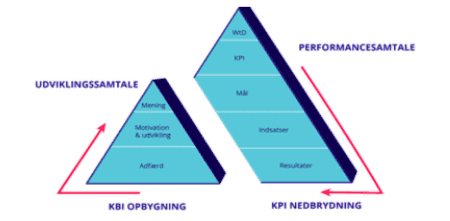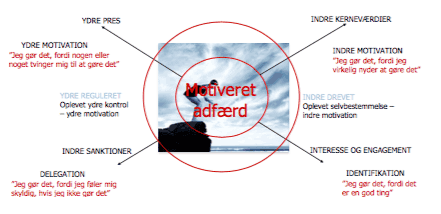Get 4 concrete tools to set a direction
In this article, we focus on how to make the connection between direction and results. Anyone can set direction, but in order to create results with others, you need to make it meaningful and motivating for employees to follow that direction and create the desired results. If leaders can't provide meaningful direction, employees will find their own meaning and direction, which may not always be the most valuable for the organization.
Read on for an introduction to four tools that can help you make your organization's direction meaningful and motivating for employees.
Start with 'why'?
The recommendation to start with WHY, which is also the title of Simon Sinek's (2012) bestselling book, raises 3 fundamental questions:
- What is your organization's higher purpose? Who are we? And what is our contribution to the world? A clear answer to the big WHY creates a framework for employee identification and meaning-making, which is a basic human need.
- Can I see myself in this purpose? Is it a 'club' I want to belong to? The purpose should offer a framework for employees to identify and create meaning, as well as communicate a narrative about the company to those around them.
- Do the outside world and employees perceive the organization's self-presentation as credible? Is there a perceived connection between the company's concrete actions and the higher purpose?
This is an introduction to 4 tools that show how you as a leader can connect organizational direction and meaning with employee core values and support intrinsically motivated behavior.
READ MORE ABOUT OUR EDUCATION
Want to get even better equipped to manage processes?
The Process Consultant program gives you the methods to design, facilitate and lead strategic development processes and changes to create the impact you need.
This is an education for those who work with development, processes and change management.
Tool 1: Break down abstract KPIs into locally meaningful performance and learning goals
The Leadership Commission points out that one of the major challenges in public organizations is that meaning is often lost between the chains of command. A challenge that many large private companies can probably recognize as well.
The model below can be used to focus on three key points:
- Create a clear thread from the big WHY to the results to be created in the organization through your communication - in principle, everyone should always be able to see the connection: "I'm cutting stones because we're building a cathedral." And that requires lots of meaningful communication at all levels of management.
- A value-creating chain of activities cannot be created through top management on KPIs and targets alone, but must always be followed up by meaningful management communication and translation at all management levels. This also means that middle managers and employees should not be micromanaged on targets and initiatives, but that top management must show trust and leave room for local translation work.
- Measuring results does not increase an organization's capacity to create results for the future. Leaders at all levels must therefore always ensure a balanced focus on short-term performance creation and long-term organizational capability building, including the development of employee skills, behavior and mindset. Otherwise, the pyramid will tip.

Tool 2: Understand how to support intrinsic task motivation
There are three key human needs that you as a manager should focus on meeting in your employees to support their intrinsic task motivation.
- Meaning: A fundamental driver of human action is meaning - we make meaning based on our cognitive frame of reference and in relation to our understanding of who we are and where we belong. Good leadership communication that establishes meaning and trust that we are 'in the same boat', working towards the same common purpose, plays a crucial role in this context.
- Mastery: We all need to feel competent at what we do, but we also need to develop our skills. For managers, it's all about ensuring a good balance between development opportunities and a sense of mastery. That's why you must always work just as hard to create a good learning environment with a focus on talent development, knowledge sharing and feedback as you work to create operational results.
- Empowerment: Leaders share your power - offer empowerment within the given framework and clarify responsibilities. Demonstrate trust - and minimize the use of external behavioral controls. When the direction is clear and meaningfully communicated, it's not 'dangerous' to open up participation - it's dangerous not to.

The art of implementation
We offer management and organizational sparring, research-based training and presentations on implementation as well as training courses with a specific focus on giving you and your organization general implementation skills. Read examples of our services here.
Tool 3: Bridge the gap from 'external pressure' to internal core values
The three key points of this model, inspired by Ryan and Deci's (2000) theory on the conditions for intrinsically regulated work motivation, are as follows:
- Work motivation is complex and complex - there are almost always elements of both extrinsic and intrinsic motivation influencing our behavior at any given time. Some tasks I love more than others, but even the most beloved tasks contain a sliver of being a means to an end beyond the joy of the task itself.
- Understand your employees' inner core values: ''What elements of work energize them the most? What is it that they do because they really enjoy doing it? This will give you insight into how to best support meaning, mastery and empowerment.
- Understand how, by supporting the needs for meaning, mastery and empowerment, you can bridge the gap from 'external pressures' to 'internal core values'.

Tool 4: Make the meaning of the work visible
Here are two ways to make the meaning of work visible to employees:
- Establish positive recipient contact that highlights how an employer has benefited from the employee's work performance. This can 'boost' intrinsic motivation and thereby efficiency, quality and well-being (Adam Grant 2012).
- Establish data-based feedback on the effects of the employee's work performance. It is more motivating for most employees, whose core values are often linked to making a positive difference for the target group, if we also measure and provide feedback on the effects of the efforts. As opposed to only measuring the number of initiatives.
These were four tools for setting direction that create meaning and motivation - use them thoughtfully and with empathy for the individual's life world. Enjoy your leadership work.



